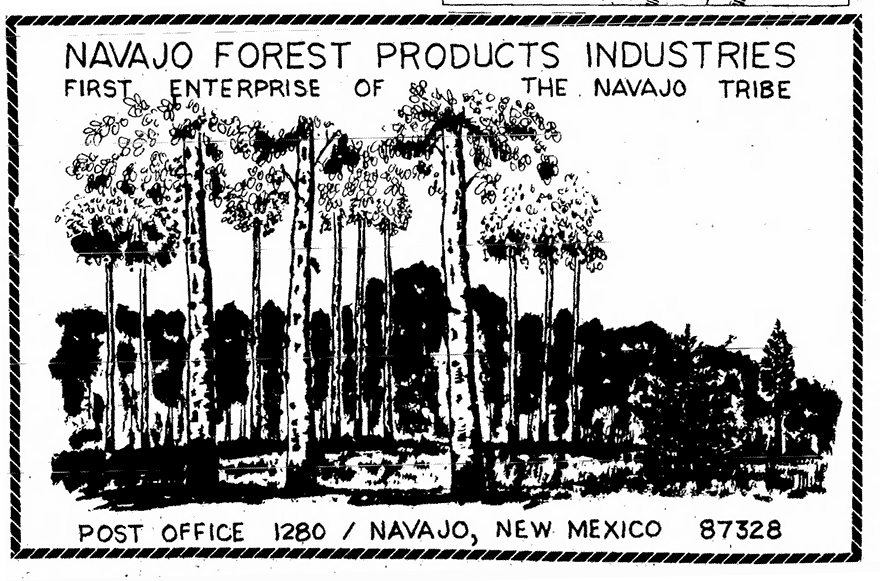
50 Years Ago: NFPI workers get a raise – 2nd in 6 months

Navajo Forest Products Industries ad that appeared in the Oct. 11, 1973, edition of Navajo Times.
If you were one of the 325 people who worked for Navajo Forest Products Industries at the beginning of 1969, you must have felt privileged.
After all, in June 1968 the board of directors for the tribal enterprise gave you a 6-cent-per-hour raise and, six months later, they are giving you another 6-cents-an-hour raise.
The company says it is doing such good business that it can offer this raise to all employees. The increase brings the wage of most employees at the plant up to $2.12 per hour. In other news, the Navajo Times decided this week to give a young student from Wingate High School, Johnny Harvey, a platform to expound on his views about the BIA. And Harvey didn’t pull any punches. “My opinion is that we would be better off without the aid of the BIA,” he wrote in a column for the Navajo Times. He said he believed that the Navajo Tribe would be able to run its own affairs without any interference from the BIA.
“I think the Navajo Tribe could accomplish more, do it better and achieve more without the BIA,” Harvey said. Harvey’s commentary foreshadowed what would happen within the tribe in the early 1970s as the next chairman, Peter MacDonald, would push for the BIA to turn over most of its authority to the tribal government.
Harvey pointed out that when the Navajos came back to the reservation in 1868, the Navajo people were taught to be dependent on the federal government for practically everything so it just became a way of life. But the tribe has grown over the past couple of decades and is now in the position of taking back much if what it gave up.
“We can handle our problems better because we know them,” he said. He questioned, however, whether the Navajo people as a whole felt the way he did. Did they want to continue to have the federal government control all parts of their life? “We are going to fail altogether if we don’t take up our own responsibilities, he said.
Dick Hardwick, the managing editor of the Times, said he was impressed by Harvey’s logic and ability to focus on one of the biggest problems the tribe would be facing over the next few years. He said he decided to give Harvey’s column prominent play in the paper to see what kind of reaction it got from other readers.
All of this was even more interesting when you realize that Hardwick was risking his job since he was actually a BIA employee who had been assigned to work as editor of the paper to help out the tribe’s chairman, Raymond Nakai, who was unable to find anyone to take the job after Chet Macrorie was fired by the Council.
He always said that he would one day go back to work for the BIA but this not keep him from promoting in the paper the idea that maybe the days of the BIA running the show were over.
The Times, in its Jan. 19 issue, had an article promoting a new type of house that had just been completed in Crownpoint that could change the issue of housing in the reservation. Two model homes were opened up in Crownpoint on Jan. 4. Both were designed by George Musser, an employee for the Eastern Navajo Agency of the BIA.
The two houses were built through a cooperative agreement signed by the Navajo Tribe, the Indian Health Service, the Navajo Office of Economic Opportunity and the BIA. It seemed that all of these agencies felt that the new houses would be game changers and would bring forth a new era in housing on the reservation.
The houses were designed as a sort of hogan-shaped structure with the kitchen and living room in the center of the house. The stove is also in the center of the house. Both the roof and the floor were made of plywood and the paneling was made of pine. The idea was that these two homes would become model homes that would attract the attention of Navajos who wanted something between a traditional hogan and a modern home.
Officials thought this would be so appealing that it would become the dominant type of home on the reservation. The problem may have been that it was too radical for its time since it never attracted much interest from the U.S. Department of Housing and Urban Development, and never really had a chance of taking over the reservation housing market.
To read the full article, pick up your copy of the Navajo Times at your nearest newsstand Thursday mornings!
Are you a digital subscriber? Read the most recent three weeks of stories by logging in to your online account.







 Highway 264,
Highway 264, I-40, WB @ Winslow
I-40, WB @ Winslow